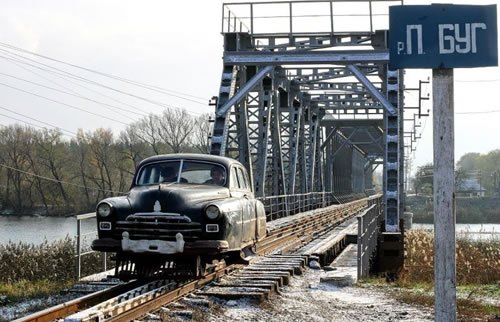Taxes Subsidize 6.9m Mass Transit Riders; Most Poor People Drive to Work
Despite the billions in federal and state taxpayer dollars poured into mass transit programs, only 6,908,323 working Americans take advantage of the subsidized service, according to US Census Bureau data released yesterday. The agency’s American Community Survey, a questionnaire mailed to three million households, found that 121,248,284 workers over the age of 16 regularly commuted to work by personal automobile or carpool last year. Despite the comparatively small number served by buses, subways and rail, the Obama Administration has made expanding mass transit a top priority. “President Obama’s vision of robust, high-speed rail service offers Americans the kind of travel options that throughout our history have contributed to economic growth and enhanced quality of life,” Transportation Secretary Ray LaHood said in April. “We simply can’t build the economy of the future on the transportation networks of the past.”
The stimulus bill poured $8 billion into the president’s proposed expansion of rail. Another $8.4 billion in taxpayer funds have been directed to “stimulate” mass transit on top of the existing federal money set aside for such programs. The president’s 2010 budget sought $42 billion for highway spending compared to $10.3 billion for mass transit programs that serve just five percent of the working public. The president strongly defended his priorities.
“Investing in mass transit and high-speed rail, for example, doesn’t just make our downtowns more livable; it helps our regional economies grow,” Obama explained in a July speech at an urban policy roundtable. “So you take an example like… Kansas City. One idea there focuses on transforming a low-income community into a national model of sustainability by weatherizing homes and building a green local transit system.”
The combined federal spending on transit this year represents a $2300 subsidy for each passenger, not including local and state funds devoted to such programs. Taxes on motorists, including a direct 2.9 cent per gallon federal levy on gasoline, are the primary source of funds for subway, bus and rail systems.
The census survey also showed that greater numbers of the working poor used cars and carpools to get to work than transit. A total of 17 percent of transit users reported incomes over $75,000 per year in income while only 10.6 percent fell below the poverty line.
A copy of the census results can be found in a 1.5mb PDF file at the source link below.
Means of Transportation to Work by Selected Characteristics (US Census Bureau, 10/27/2009)
[courtesy of thenewspaper.com]
More by The Newspaper
Latest Car Reviews
Read moreLatest Product Reviews
Read moreRecent Comments
- Theflyersfan The wheel and tire combo is tragic and the "M Stripe" has to go, but overall, this one is a keeper. Provided the mileage isn't 300,000 and the service records don't read like a horror novel, this could be one of the last (almost) unmodified E34s out there that isn't rotting in a barn. I can see this ad being taken down quickly due to someone taking the chance. Recently had some good finds here. Which means Monday, we'll see a 1999 Honda Civic with falling off body mods from Pep Boys, a rusted fart can, Honda Rot with bad paint, 400,000 miles, and a biohazard interior, all for the unrealistic price of $10,000.
- Theflyersfan Expect a press report about an expansion of VW's Mexican plant any day now. I'm all for worker's rights to get the best (and fair) wages and benefits possible, but didn't VW, and for that matter many of the Asian and European carmaker plants in the south, already have as good of, if not better wages already? This can drive a wedge in those plants and this might be a case of be careful what you wish for.
- Jkross22 When I think about products that I buy that are of the highest quality or are of great value, I have no idea if they are made as a whole or in parts by unionized employees. As a customer, that's really all I care about. When I think about services I receive from unionized and non-unionized employees, it varies from C- to F levels of service. Will unionizing make the cars better or worse?
- Namesakeone I think it's the age old conundrum: Every company (or industry) wants every other one to pay its workers well; well-paid workers make great customers. But nobody wants to pay their own workers well; that would eat into profits. So instead of what Henry Ford (the first) did over a century ago, we will have a lot of companies copying Nike in the 1980s: third-world employees (with a few highly-paid celebrity athlete endorsers) selling overpriced products to upper-middle-class Americans (with a few urban street youths willing to literally kill for that product), until there are no more upper-middle-class Americans left.
- ToolGuy I was challenged by Tim's incisive opinion, but thankfully Jeff's multiple vanilla truisms have set me straight. Or something. 😉


































Comments
Join the conversation
geeber: When heading into Philly, I take the train, which takes slightly longer and is surely more expensive (for me) just to avoid the Sure-Kill. It's typically worse than L.A. traffic. Going to D.C. can be silly. The beltway routes are more jammed shut than downtown, and using the Interstates that take you within blocks of the White House is faster than fighting the daily suburban transhumance. I'm happy to pay for mass transit systems. It frees up the roads and gives me some options (some times). If we're worried about highway maintenance we need to have a different conversation, one about heavy multi-axle trucks, since they are responsible for nearly all surface wear.
@FreedMike, My only beef with your otherwise dead-on post is your city size estimates. Seattle isn't "twice the size" of Denver. ;) Good post. And for the guy who says Fed money isn't used for highways outside of the stimulus, you'd be wrong.